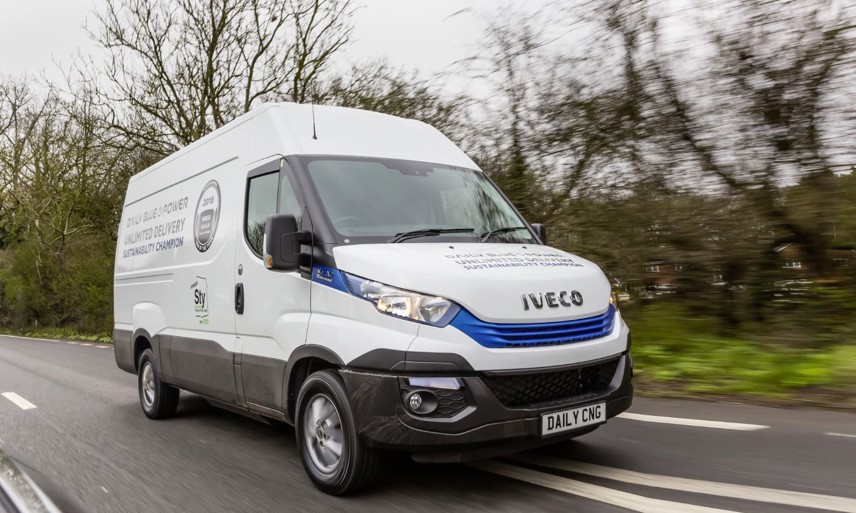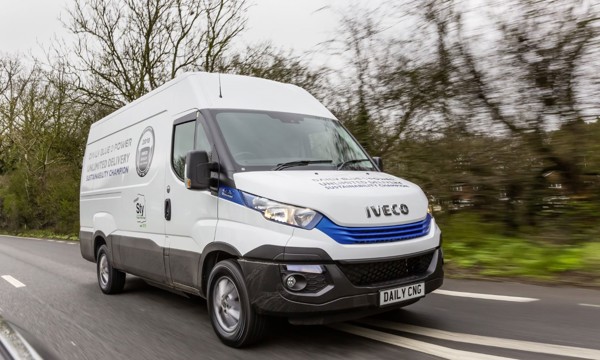Review
Latest Daily trio aim to put operators in the good books of clean air authorities .By Matt de Prez
Iveco’s new trio of Blue Power Daily models are aimed at tackling the latest demands from legislators to lower tailpipe emissions.
The range includes diesel-, gas- and electric-powered versions of the existing Daily.
The Daily RDE-ready uses a revised version of the existing 2.3-litre diesel engine. In real world testing it meets the 2020 RDE-2 emissions regulations.
The result is achieved by fitting an AdBlue system in conjunction with Iveco’s Euro 6 SCR technology.
Operators should expect a fuel saving of 7% compared with the standard diesel model, although it is expected to cost £800-£1,000 more.
The 3.5-tonne van comes with payloads ranging from 1,099kg to 1,356kg – around 40kg less than non RDE-ready diesel versions.
For operators working in an urban environment, the Daily Natural Power (NP) Hi-Matic combines a natural gas engine with an eight-speed automatic gearbox.
When running on compressed natural gas (CNG), the Daily NP emits 251g/km of CO2 (NEDC).
Iveco says it actually emits 5% less CO2 than a regular diesel in real-world conditions and this will be reflected in upcoming WLTP testing, which comes into effect next September.
During independent testing by LowCVP, a Daily NP emitted less than 200g/km during real-world motorway testing.
Using bio-gas can further reduce emissions, by up to 95%.
Combined with the automatic gearbox, driver fatigue should be reduced. The driving experience is similar to the diesel. It is also quieter, so better suited to night-time deliveries.
The 3.5-tonne versions offer payloads spanning 795 -1,062kg. Gas tanks fitted to the chassis provide storage for 190-250 litres of gas, which give a range of more than 250 miles.
The Daily Electric offers a zero-emission solution for inner-city use. It has a range of around 80 miles, although additional batteries can be specified – at the expense of payload – increasing the range to 125 miles.
Up to 1,300kg can be carried in 3.5-tonne versions, although Iveco says a 4.25-tonne version is available with a greater payload to suit licencing changes, which allow drivers with a car licence to drive electric vehicles with a gross weight of 4.25 tonnes instead of 3.5 tonnes.
Iveco doesn’t have an official price list as its dealers negotiate with individual buyers on a case-by-case basis, but a two battery model costs around £84,000. A 20% Government grant reduces this to £64,000.
The manufacturer claims that an electric model operated in London becomes cost-neutral against a diesel within six years due to savings in congestion charge and fuel.
All Daily models benefit from a robust and logical interior layout, which clearly draws from Iveco’s truck experience.
The body-on-chassis construction means the Daily is easy to convert and more capable at dealing with heavier loads that its competitors.
As a truck manufacturer, Iveco offers the same high-level aftersales support and 24-hour dealership service to its van customers as it does to truck ones.
Of the three variants the diesel still demonstrates the best all-round package.
RDE-ready models will suit fleets with longer lifecycles that are concerned about future emissions restrictions. They also offer the best driving experience with strong torque and refinement.
While the gas-powered Daily is a sound alternative to diesel in terms of usability, the fuelling infrastructure restricts it to shorter routes or smaller areas.
Verdict
Our test of the Daily Electric took it out of its comfort zone and onto country lanes where it struggled with hills and provided disappointing performance.
However, in a city these issues would be less relevant – especially for multi-drop deliveries.







 Diesel
Diesel













